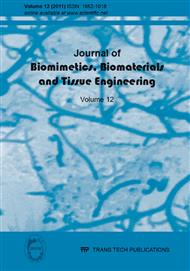[1]
S. Breusch, C. Heisel, J. Müller, T. Borchers, H. Mau. Influence of cement viscosity on cement interdigitation and venous fat content under in vivo conditions. A bilateral study of 13 sheep,. Acta Orthop Scand, Vol. 73 (4) (2002), 409-415.
DOI: 10.1080/00016470216320
Google Scholar
[2]
W. R Krause, J. Miller, P. Ng. The viscosity of acrylic bone cements,. Journal of Biomedical Materials Research, Vol. 16 (1982), 219-243.
DOI: 10.1002/jbm.820160305
Google Scholar
[3]
P. C Noble, E. Swarts. Penetration of Acrylic Bone Cements into Cancellous Bone,. Acta. Orthop. Scand, Vol. 54 (1983), 566-573.
DOI: 10.3109/17453678308992890
Google Scholar
[4]
G. Baroud, J. Z Wu, M. Bohner, S. Sponagel, T. Steffen. How to determine the permeability for cement infiltration of osteoporotic cancellous bone,. Medical Engineering & Physics, Vol. 25 (2003), 283–288.
DOI: 10.1016/s1350-4533(02)00223-0
Google Scholar
[5]
G. Baroud, F. B Yahia. A finite element rheological model for polymethylmethacrylate flow,. Proc. Instn Mech. Engrs, Vol. 218, Part H: J. Engineering in Medicine, 331-338.
DOI: 10.1243/0954411041932827
Google Scholar
[6]
D. F Farrar, J. Rose. Rheological properties of PMMA bone cements during curing,. Biomaterials, Vol. 22 (2001), 3005-3013.
DOI: 10.1016/s0142-9612(01)00047-3
Google Scholar
[7]
Online fidap user manual, last accessed on 3rd june, 2005. (Registration required to access the site) http: /www. fluentusers. com/fidap/doc/ori/html/fidap/fd-c. htm.
Google Scholar
[8]
N. J Dunne, J. F Orr. Development of a computer model to predict pressure generation around hip replacement stems,. Proceedings Of The Institution Of Mechanical Engineers, Part H, Journal of Engineering in Medicine, Vol. 214, Issue 6 (2000).
DOI: 10.1243/0954411001535679
Google Scholar
[9]
N. J Dunne and J. F Orr. Influence of mixing techniques on the physical properties of acrylic bone cement,. Biomaterials, Vol. 22, Issue 13 (2001), 1819-1826.
DOI: 10.1016/s0142-9612(00)00363-x
Google Scholar
[10]
Y. P Arramon, E. A Nauman. The Intrinsic permeability of Cancellous Bone" from "Bone Mechanics Hand Book, (2nd Edition) - Edited by Stephen C. Cowin, (2001).
Google Scholar
[11]
T. M Keaveny. Cancellous bone. Handbook of Biomaterial properties. Edited by J. Black and G. Hastings. Chapman & Hall, First Edition, (1998).
Google Scholar
[12]
N. J Dunne, J. F Orr, D. J Heylings. Measurement of Intermedullary Cement Pressure,. Innovation and Technology in Biology and Medicine, Vol. 19(5) (1998), 347-359.
Google Scholar
[13]
J. D Bryant, T. David, P. H Gaskell, S. King, G. Lond. Rheology of bovine bone marrow,. Proc Inst Mech Eng, [H] Vol. 203, Issue 2 (1989), 71-75.
DOI: 10.1243/pime_proc_1989_203_013_01
Google Scholar
[14]
F. Canabal and B. Katz. A computational fluid dynamics simulation of PMMA cement flow upon insertion of a femoral stem into a bone cavity during a total hip prosthesis procedure,. Advances in Bioengineering, Vol. 28, ASME, (1994), 165-166.
Google Scholar
[15]
Y. P. Arramon, E. A. Nauman The Intrinsic permeability of Cancellous Bone" from "Bone Mechanics Hand Book, (2nd Edition)- Edited by Stephen C. Cowin, (2001).
Google Scholar
[16]
M.M. Rahman. Finite Element Modelling of Rheological and Penetration Characteristics of Curing PMMA Bone Cement in Total Hip Replacement,. PhD thesis, Dublin City University, Dublin, (2006).
Google Scholar


